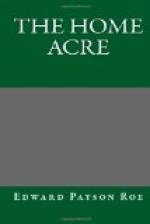In setting out plants, the principle of sex should be remembered. The majority of our favorite varieties are bisexual; that is, the blossoms are furnished with both stamens and pistils. A variety with this organization, as the Sharpless, for instance, will bear alone with no other kind near it. But if one set out a bed of Champions—another fine variety—well apart from any staminate kind, it would blossom profusely, but produce no fruit. When I was a boy, Hovey’s Seedling was the great strawberry of the day, and marvellous stories were told of the productiveness of the plants and the size of the berries. How well I remember the disappointment and wrath of people who bought the plants at a high price, and set them out with no staminate varieties near to fertilize the pistillate blossoms. Expectations were raised to the highest pitch by profuse blossoming in May, but not a berry could be found the ensuing June. The vigorous plants were only a mockery, and the people who sold them were berated as humbugs. To-day the most highly praised strawberry is the Jewell. The originator, Mr. P. M. Augur, writes me that “plants set two feet by eighteen inches apart, August 1, 1884, in June, 1885, completely covered the ground, touching both ways, and averaged little over a quart to the plant for the centre patch.” All runners were kept off, in accordance with the system advocated in this paper. “At Boston a silver medal was awarded to this variety as the best new strawberry introduced within five years.” People reading such laudation—well deserved, I believe—might conclude the best is good enough for us, and send for enough Jewell plants to set out a bed. If they set no others near it, their experience would be similar to that which I witnessed in the case of Hovey’s Seedling thirty odd years ago. The blossom of the Jewell contains pistils only, and will produce no fruit unless a staminate variety is planted near. I have never considered this an objection against a variety; for why should any one wish to raise only one variety of strawberry? All danger of barrenness in pistillate kinds is removed absolutely by planting staminate sorts in the same bed. In nurserymen’s catalogues pistillate varieties are marked “P.,” and the purchaser has merely to set out the plants within a few feet of some perfect flowering kind to secure abundant fruit.
As a result of much experience, I will now make some suggestions as to varieties. In a former paper I have given, the opinions of others upon this important subject, and one can follow the advice of such eminent authorities without misgiving. The earliest strawberry that I have ever raised, and one of the best flavored, is the Crystal City. It is evidently a wild variety domesticated, and it has the exquisite flavor and perfume of the field-berry. It rarely fails to give us fruit in May, and my children, with the unerring taste of connoisseurs, follow it up until the last berry is picked. It would run all over the garden




